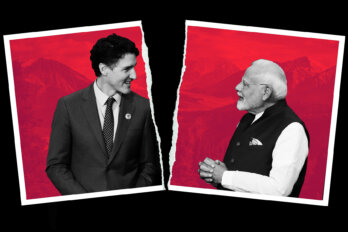On the morning of January 28, a pickup prowled Ottawa’s downtown core. It was a Dodge Ram, dark and dirty, with a hood cover and a cracked front bumper—the type of truck that attracts attention when its 325 horsepower engine gets throttled. But it wasn’t simply the sound of its motor that might have drawn locals’ attention. It was the two flags flying from the truck’s bed. On the driver side, there was an upside-down Maple Leaf—a signal of distress. And, out of the passenger side, there was the Confederate battle flag. One of the first photos of the truck to be widely circulated on Twitter situated it near Ottawa City Hall, on Elgin Street, halfway between the National War Memorial and Ottawa police headquarters.
I live in Ottawa with my family and didn’t quite know what to make of that pickup when it popped up in my Twitter feed. For days, my neighbours and I had been hearing about scores of trucks rolling toward us. No one knew how many were on their way or how many protesters there would be. Predictions varied from a few thousand people to organizers’ claims of about 50,000 trucks. The convoy had been building ever since it first departed from British Columbia, six days earlier. Many in the procession weren’t truckers at all but sympathizers with trailers and rigs of their own. Some were against vaccine mandates. Others were just tired of the pandemic and believed the government had gone too far with its lockdowns and travel limitations. Some came to rid the country of its elected leaders, with police warning about weapons. A number brought along their children and pets, prepared for a long occupation of Ottawa’s business centre and parliamentary precinct.
As the convoy travelled, it grew, and the larger it got, the more blurred the protest’s objectives seemed to become. One of the groups at the centre of the initial convoy was Canada Unity, which started in 2019 as a conspiracy-minded Facebook page run by a husband and wife from Alberta who posted updates from their motorhome as they travelled. Then new faces cropped up. A former energy-industry worker and bar-band singer active in the Wexit secession movement emerged as a leader. Another key figure was a vocal TikTok user who recorded video rants from the driver’s seat of his truck. Canada Unity put together a manifesto of sorts—a so-called memorandum of understanding—that called on the governor general and the Senate to either end all vaccine “regulations, initiatives, and mandates” or step down immediately. It was joined by a separate document circulating online: a fake arrest warrant against the prime minister for tyranny and complicity in crimes against humanity.
By Saturday, January 29, hundreds of trucks and motorhomes had ground to a halt inside the downtown core. Drivers leaned hard on their horns. Others removed their wheels so that their vehicles could not easily be moved. Meanwhile, demonstrators stepped out of hotels and cars and the light-rail transit stations that run under the city. Like the convoy, many had been communicating online. But now they were together, on foot. They moved fast toward Parliament Hill, brandishing flags and placards. Others set up loudspeakers and sirens. Someone brought a crane. It became increasingly difficult for those who weren’t part of the convoy to understand all of its demands or how such a disparate cross-section of society had even managed to converge into such a movement.
That confusion was quickly exploited. Mixed in with the travelling mass were far-right groups that had been growing online for years. Among them were conspiracy influencers—former soldiers bent on creating a new world order; QAnon followers intent on putting journalists, scientists, and academics on trial; and young men in baseball caps promoting their right-wing social media brands. It was a motley collection, but as the protest entrenched, it looked at times more peaceful than extremist. Portions of Ottawa’s downtown took on the air of a Mad Max–themed block party. There was a soundstage and a hot tub. There were disc jockeys, bouncy castles, and barbecues. The convoy raised millions of dollars. Thank you cards were left on the occupying trucks along with gas cans, sandwiches, and hot dogs. Signs left on the gates of Parliament read things like “Sorry, citizens of Ottawa! The rest of Canada thanks you!”
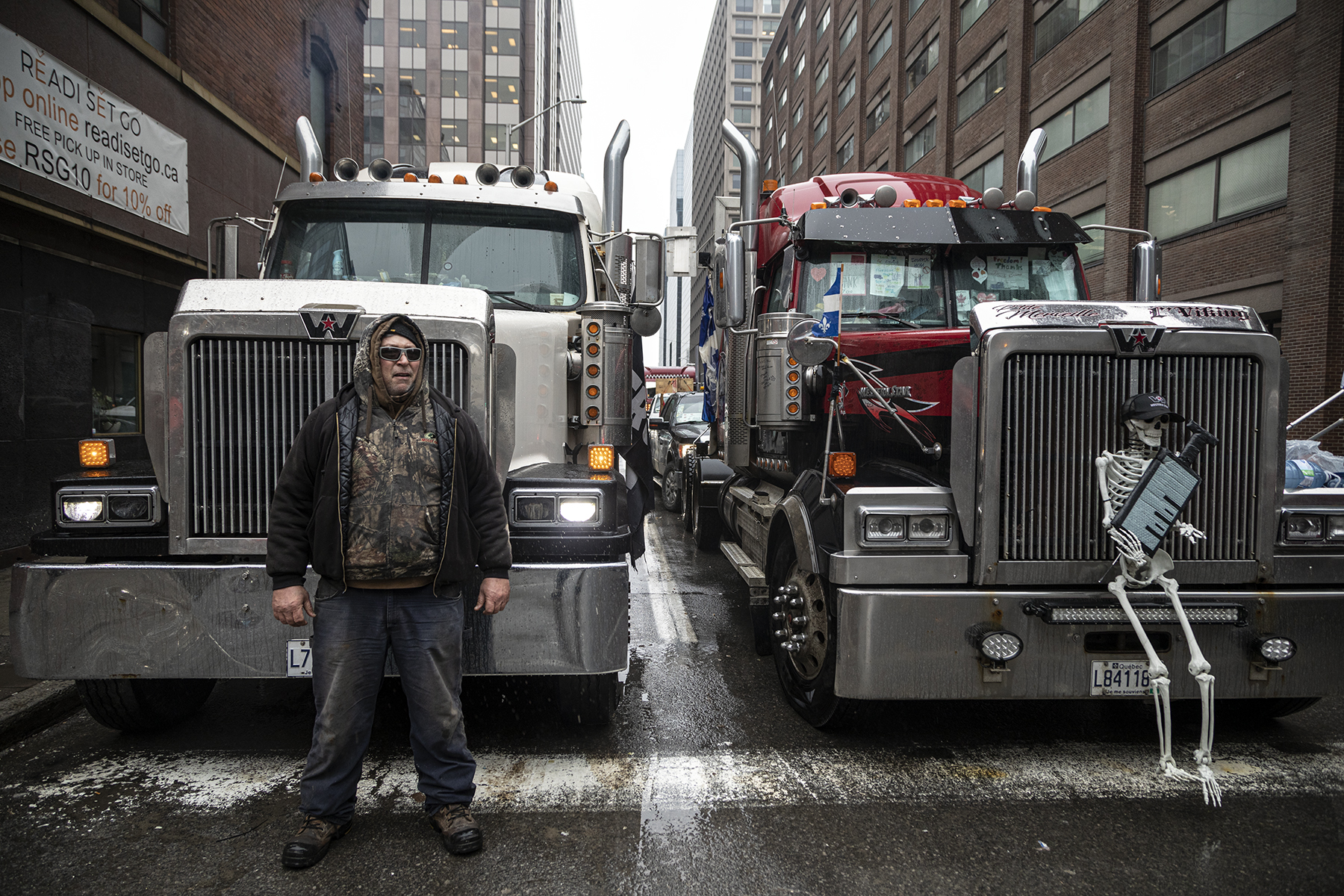
For residents who actually lived in the occupied parts of the city, it felt like their rights to peace, order, and good government were being held hostage. It became clear just how well-organized the more subversive groups really were. The supply chain was sophisticated: wood, food, fuel. Members of these groups consisted of former military personnel and former cops. They’d been written off as “fringe.” Many spread misinformation over platforms like YouTube, Trovo, and Telegram, which they also used to form communities that rallied behind central figures. This collective of streamers—whether preaching like online clerics against pandemic restrictions or swapping conspiracy theories on Facebook and Discord—fuels combustible echo chambers that can boil over to harass users they disagree with. Or they target civilians, as happened to the twenty-one-year-old Ottawa woman who, a week into the protests, triggered the court injunction aimed at silencing the truck’s horns.
None of these tactics were particularly new. The difference was that the trolls were now targeting an entire city. When the Ottawa Police Service said that it was being overwhelmed by false 911 calls, it was disclosing to the world that the trolls were jamming emergency lines. When the same police force said it was focused on cutting access to fuel for the convoy trucks, Pat King, a convoy organizer and self-declared “investigative journalist,” took to his Facebook page to call on everyone to descend on Ottawa with gas cans. It was a bid to prolong what police had called “a siege” of the capital.
Suddenly all the baiting, goading, and instigating that had long been a part of digital life was spilling out into the real world. Much of the trolling that happened over the three weeks of the Ottawa protest was illegal and dangerous. The more conspiratorial elements blended in with the crowd of discontented. In some cases, they posted photos and videos of themselves to social media. In other cases, their presence can be traced through the symbols that were left in the crowd. Amid the seemingly innocuous—from the Maple Leaf tied to hockey sticks and draped over a statue of Terry Fox to the provincial flags and the Stars and Stripes—were more troublesome signs. Some were easy to recognize. Others weren’t. Decoding them is a step toward understanding the mindsets bent on something darker: factions that pose a threat not just to the state but to citizens who rely on the state to live peaceful lives.
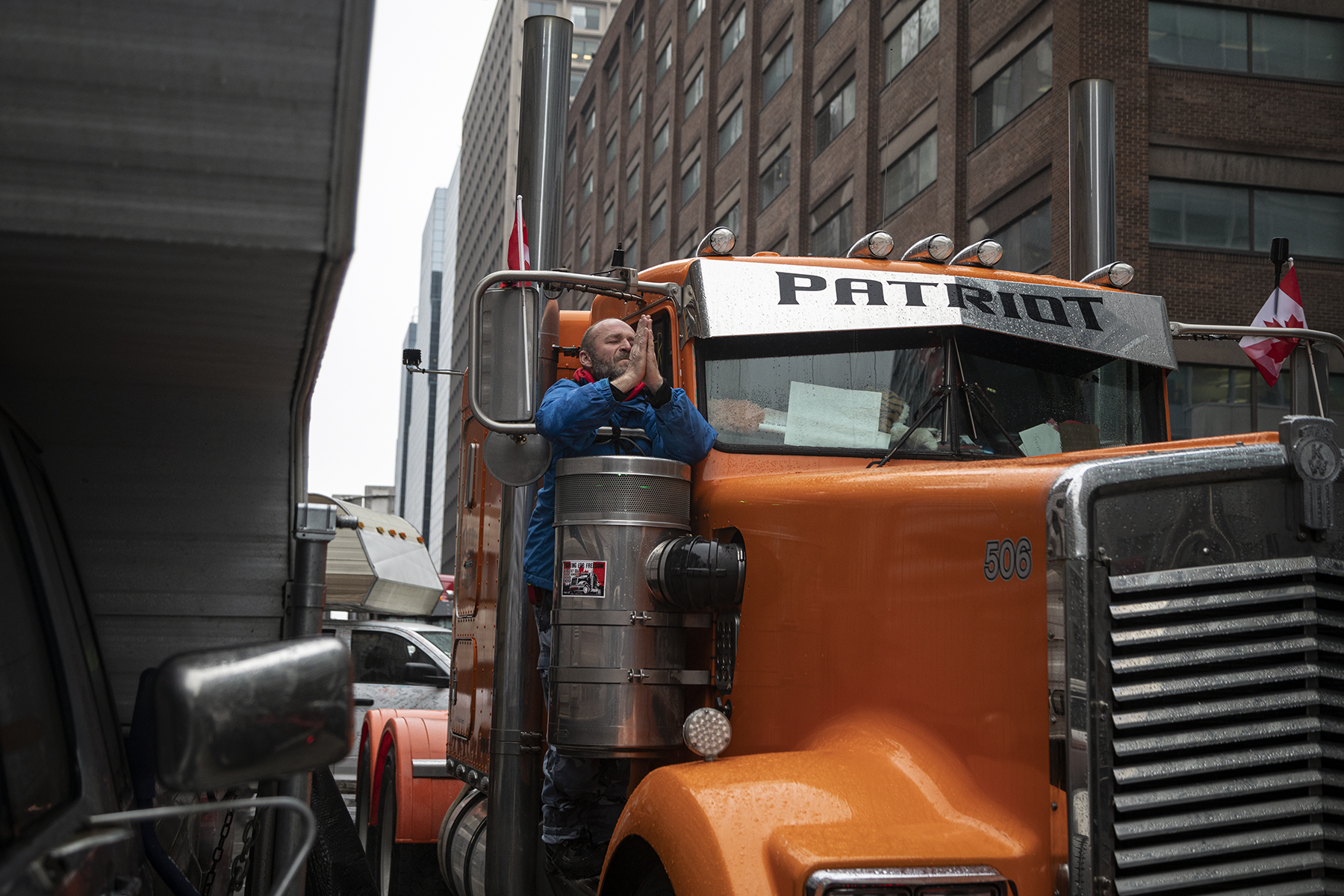
The ground inside what police called “the red zone” bristled with iconography, much of it appropriated. It’s no surprise that the media, here and abroad, was immediately drawn to the Nazi swastikas and Confederate battle flags. There were other flags that stood out in the crowd, like the Gadsden, consisting of a coiled rattlesnake on a yellow background. Designed during the American revolutionary period, it’s considered by some an emblem of personal freedom. Then there were flags that went largely overlooked, such as the Patriote, which dates from the 1830s and the Lower Canada Rebellion, when French Canadian militants took up arms against the British Crown. In the 1960s, the green, white, and red flag became associated with Front de libération du Québec separatists. More recently, it has been adopted by La Meute, far-right ultranationalists from Quebec whose members were spotted in the crowds in Ottawa. Versions of the Patriote were present at the protest—including on Parliament Hill and down along the Rideau Canal—up to the very end.
More prevalent than either the swastika or the Confederate flag was Canada’s old flag, the Red Ensign. To many Canadians, the versions of the Red Ensign that flew over Parliament from 1945 to 1965 are barely discernible from the Ontario flag. Some versions have a Union Jack on the top left, a red background, and the shield of the Arms of Canada, which features symbols representing England, Scotland, Ireland, and France. The flag is a colonial relic hardly seen in public except at some war memorials or when displayed by the Royal Canadian Legion. Those who see it rarely know what to make of it: few understand that it has been adopted by right-wing factions as a nostalgic symbol. It has been photographed alongside swastikas in the homes of members of the Aryan Guard. In 2014, a Toronto Star reporter noticed it flying outside the home of John Beattie, who once led the Canadian Nazi Party. It was also carried over the shoulder by a member of the group of Proud Boys who confronted Indigenous activists in Halifax on Canada Day in 2017. According to Étienne Quintal, an online hate researcher at the Neuberger Holocaust Education Centre, in Toronto, the Red Ensign has become one of the most common homegrown symbols of hate.
Quintal warns that the Red Ensign is hard to associate with one group. “People who use the symbol have wildly different understandings of what it means,” he said. “For some, it’s a symbol of neo-Nazism. I would say, by virtue of the Red Ensign being an arcane flag, its usage in public is now very specific. It’s a celebration of colonialism and a call to return to the way Canada was, broadly before the 1976 Immigration Act.” I got my own sense of the flag’s widespread adoption when I met a young man in a camouflage jacket with a Red Ensign patch on his shoulder. He was walking alone near the bouncy castles and the hot tub. He said he knew the flag had far-right associations but he didn’t believe himself to be far right. He wore it, he told me, because he felt alienated from the country around him.
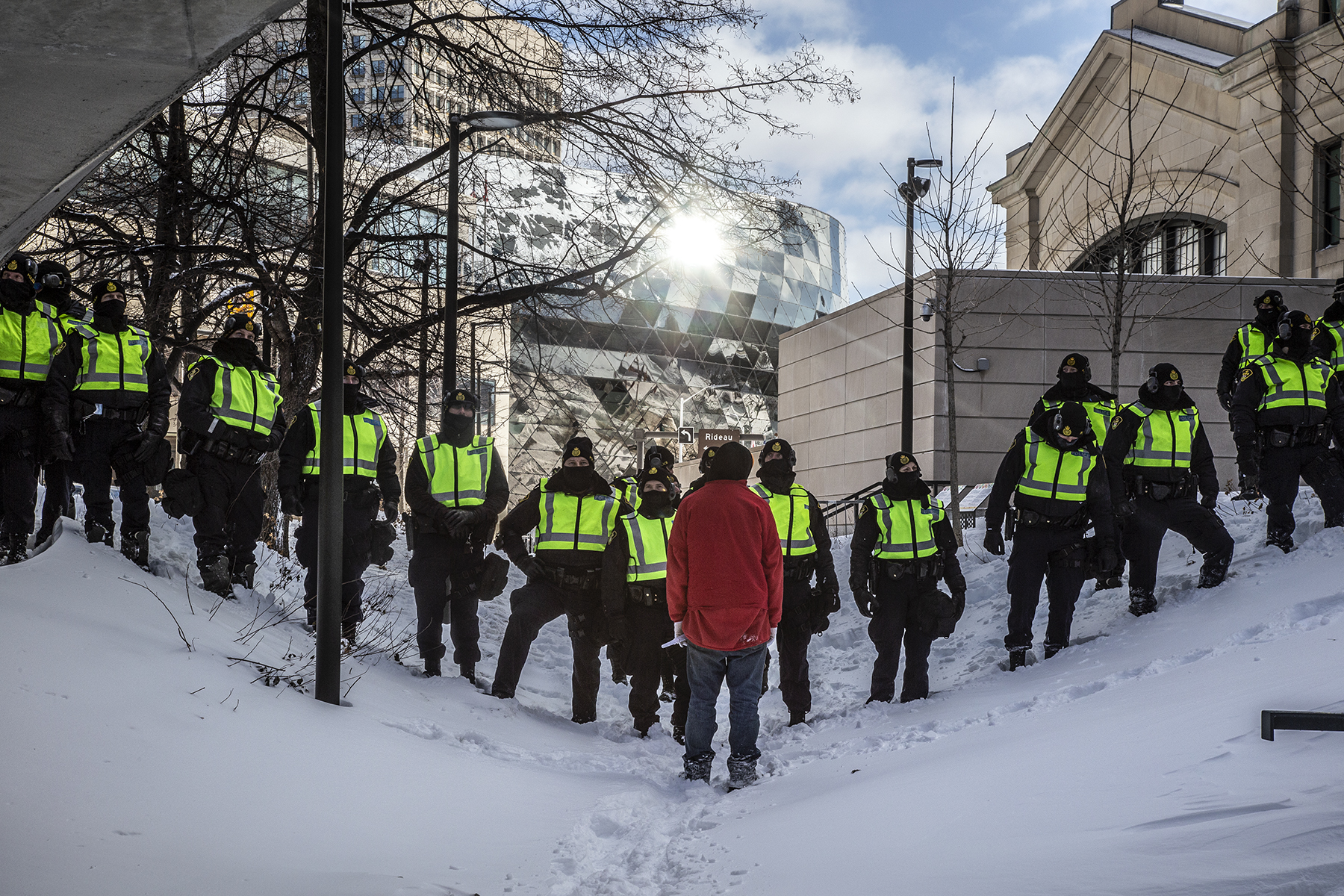
Paolo Gentile, an Ottawa-based researcher who studies how protest symbols have evolved in the age of social media, says that, while the Red Ensign and the Confederate flag may be taken up for different reasons by different groups, they symbolize frustration with existing political and social conditions. Far-right activists don’t generally see themselves reflected in the politicians Canadian society elects. Some may not even believe that Justin Trudeau is leading the country. A significant subset—over 70,000 followers—subscribes to the Telegram channel of a BC woman named Romana Didulo, a self-proclaimed “sovereign queen of the kingdom of Canada” who has ordered her followers to kill health workers. There were symbols of support for her in Ottawa too; she ultimately joined the protest to denounce Trudeau and burn a Maple Leaf flag on Parliament Hill.
Also associated with convoy participants was a black banner with a diagonal white stripe. It’s a symbol of Diagolon, a fake country that runs diagonally across North America, from Alaska through the Canadian prairies and down through the American Midwest to Florida. It’s an imaginary white ethnostate that broadly unifies Republican America with Conservative Canada. The Canadian Anti-Hate Network has described the Diagolon network as a sophisticated organization driven by an extreme ideology that seeks to overthrow the existing government. Its banner was found on a body armour vest seized by Alberta RCMP when they moved in on a smaller group within a trucker blockade at the Canada–US border. Officers also recovered multiple long guns, handguns, a machete, and ammunition, and charged four men with conspiracy to commit murder. One of the protest organizers later said they decided to end the blockade after they realized their ranks had been infiltrated by an extreme element.
Diagolon’s creator, Jeremy MacKenzie, was in Ottawa. An Afghanistan war veteran and self-described “raging dissident,” MacKenzie was arrested just days before the protest for allegedly brandishing a handgun in a Nova Scotia business. During the convoy’s initial arrival in the capital, he took time away from posing with far-right fans to appear on Infowars, a fake-news website owned by Alex Jones, the American radio host who defamed the families of children killed in the Sandy Hook Elementary School mass shooting, which he labelled a hoax. Later, when police ended the occupation, the faces and identities of the officers who had broken up the party were leaked online, and MacKenzie took to social media to share them. MacKenzie also belongs to the Plaid Army, a group of Canadian vloggers tied to Diagolon who believe a race war is underway in North America. Some members of Plaid Army embrace a distinct camouflaged version of the Red Ensign, which was also present in Ottawa during the protests.
How seriously are we to take any of this? It’s not unusual to find anonymous messages in chatrooms calling for the violent removal of politicians from society. For some, it’s a game; for others, it’s not. Two weeks into the Ottawa protests, a video emerged online via CTV reporter Glen McGregor. It seems to show protesters in a large tent, presumably an encampment. A man with a megaphone appears to deputize other protesters, which McGregor connects to something called the Canadian Common Corps of Peace Officers. “You are lawfully empowered to employ other members of the public as peace officers and to detain and arrest anyone you see breaching the public peace,” the man with the megaphone said. A few days later, reporter Justin Ling tweeted that, according to a law enforcement source, two occupiers had attempted to arrest Ottawa police officers. After the CTV video emerged, Stephanie Carvin, a former national-security analyst and current associate professor of international affairs at Carleton University, tweeted, “The closer this gets to Sovereign Citizen (aka Freeman on the land) territory, the worse off we are. There are big implications for police forces trying to contain this thing.”
The Sovereign Citizens are an international right-wing movement that doesn’t have any clearly defined leadership or doctrine. They are united in their belief that they are not bound by the laws and regulations of whatever country they live in. They have been known to create their own driver’s licences, write their own liens against government officials, contest the validity of established judicial systems, and resort to violence—especially against police—to protect their imagined rights. The Daily Beast called Sovereign Citizens “America’s Top Cop-Killers.” As Joe McIntyre, a law lecturer at the University of South Australia, wrote in The Conversation, a Sovereign Citizen faction has appropriated Australia’s own Red Ensign—essentially a red-backed version of its current flag—which has also crept into anti-lockdown and anti-government protests down under. A photo of that same flag appeared on Twitter two weeks into the Ottawa protests. I caught up with the man who had carried it. He was standing at a hot dog stand in the middle of Wellington Street. He said his name was Jacko. He was Australian, and when I asked him about the Red Ensign’s association with Sovereign Citizens, he disagreed. He was carrying other Australian flags, including the Eureka, and said they represented previous battles “against tyranny.”
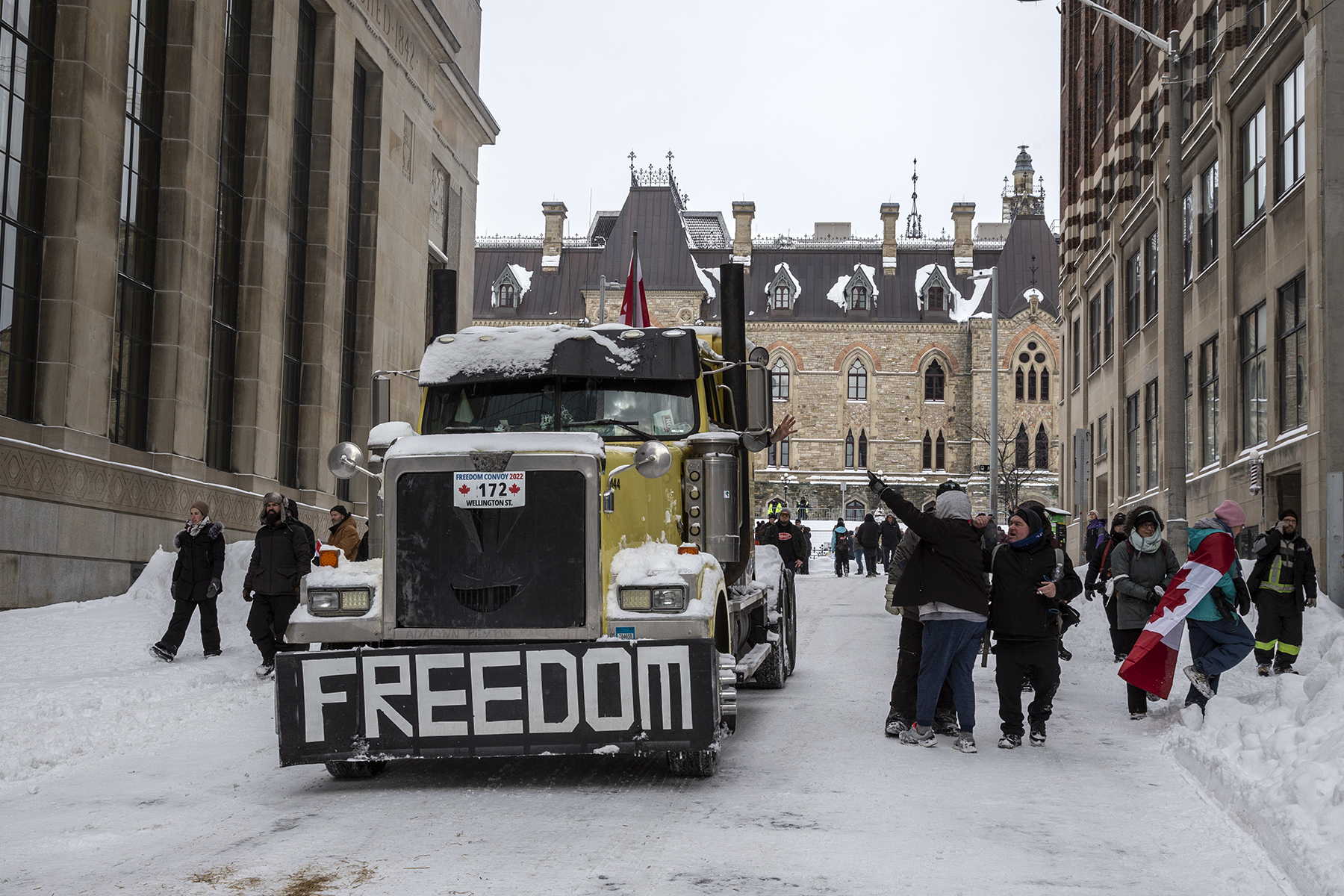
The Canadian national security analysts I spoke to wondered whether what they were seeing—such as people self-deputizing or invoking treaties that didn’t exist—were signs that Sovereign Citizens had infiltrated Ottawa or just a kind of radicalized theatre. Extreme ideas can take hold in a larger group and become normalized. When I reached out to Carvin, she seemed struck by how deeply “pseudo legal arguments” like the memorandum of understanding had become part of the Ottawa protest. “And I do worry about that,” she said, “because how do you deter someone with laws that they don’t think exist?”
On the day police finally moved in on the protesters, I spoke with Stephen Day, a security expert and former special-operations commander. He had done his own threat assessment from inside the red zone. He agreed that the protest had simply swept up people who felt left behind by the country’s current direction. But the anti-establishment figures he had identified were alarming enough. He and his colleagues have known for years that the threat from radicalized Canadians had been growing. It was hard not to think of the 2021 federal election, when protesters stalked the campaign trail and a twenty-five-year-old named Shane Marshall was charged with assault for allegedly hurling gravel at the prime minister. Search for Marshall online and you’ll come across an image of him in a ski mask, hoisting a camouflaged version of the Red Ensign. (He was arrested in Ottawa the night before police moved in to clear the protesters.) After speaking to protesters inside the occupied zone, Day concluded that their perspectives had hardened. “There were people there you cannot have a rational conversation with,” he told me. “They are through the looking glass and they are being manipulated online.”
If this is the first you’ve heard of the Plaid Army, Sovereign Citizens, or Diagolon, you may fall somewhere on the more traditional Canadian political spectrum. Living in that spectrum might make it easier to discount the significance of what happened in Ottawa and the iterations that spread to Toronto, the Ambassador Bridge, and elsewhere. That multiple cities were pushed to declare states of emergency is bad enough. That events also pushed a parliamentary democracy into a state of emergency feels unprecedented. Even after the police had retaken downtown Ottawa, many streets had been cleared, most of the protesters had been sent home, and arrests had been made, a Red Ensign could still be seen. It flew alongside the last remaining Maple Leafs. And though, as I write this, the convoy is no longer in our midst, it is not so far from us either. It has dwindled down and been broken up, but it is still parked in farmer’s fields just over the horizon. Videos from the new encampment continue to appear on my news feed. Some seem to be reliving the battle. Others appear to be regrouping for the next one.



